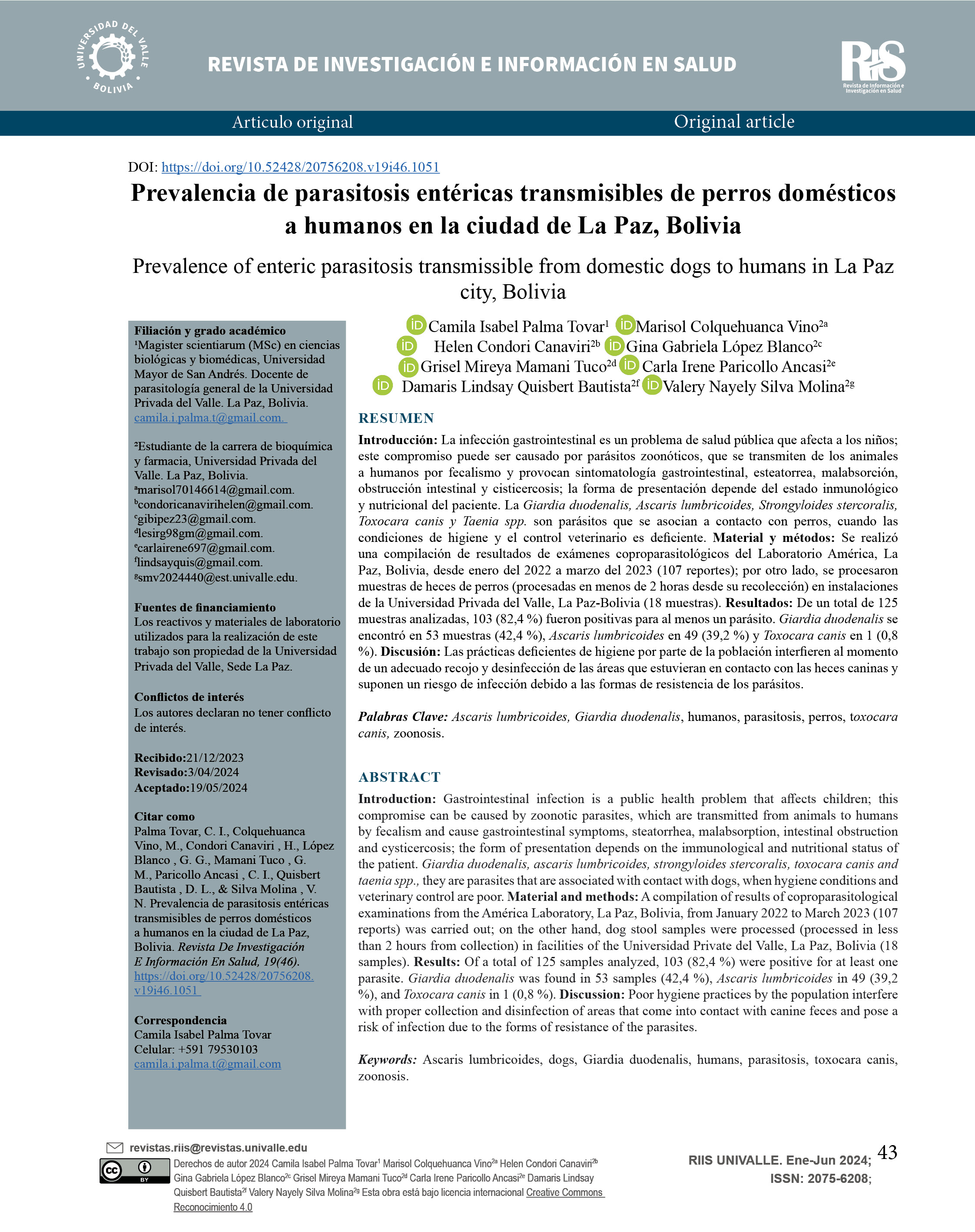Prevalence of enteric parasitoses transmissible from domestic dogs to humans in La Paz city, Bolivia
DOI:
https://doi.org/10.52428/20756208.v19i46.1051Keywords:
Parasitic zoonoses, Domestic dogs, Giardia duodenalis, Ascaris lumbricoides, Strongyloides stercoralis, Toxocara canis, Taenia sppAbstract
Gastrointestinal infections are a public health problem that especially affects children. Some of these infections are due to zoonotic parasites, which are transmitted from animals to humans through fecalism and cause gastrointestinal upset, steatorrhea, malabsorption, intestinal obstruction and cysticercosis, in according to the immunological and nutritional state of the patient. Giardia duodenalis, Ascaris lumbricoides, Strongyloides stercoralis, Toxocara canis and Taenia spp. are parasites associated with dog contact, especially when hygiene and veterinary control are deficient.
A compilation of results of coproparasitological examinations from the Laboratorio America, La Paz-Bolivia, from January 2022 to March 2023 (107 reports) was carried out. On the other hand, dog feces samples were processed (in less than 2 hours from collection) in premises of the Universidad Privada del Valle, La Paz-Bolivia (18 samples). From 125 analyzed samples, 103 (82.4%) were positive for at least one parasite. Giardia duodenalis was found in 53 samples (42.4%), Ascaris lumbricoides in 49 (39.2%) and Toxocara canis in 1 (0.8 %). Despite there being reports related to fecal-oral contact, Strongyloides stercoralis or Taenia spp. were not found.
Poor hygiene practices by thr population interfere with the proper collection and disinfection of areas that encounter canine feces and pose a risk of infection due to the forms of resistance of the parasites.
Downloads
References
Boucourt-Rodríguez E, Izquierdo-Cirer A, Bernal-Martínez E, Acosta-Gaibor MP. Vigilancia epidemiológica y prevención de las enfermedades infecciosas emergentes y re-emergentes. Journal of Science and Research: Revista Ciencia e Investigación, ISSN 2528-8083, Vol 7, No Extra 1, 2022 (Ejemplar dedicado a: CININGEC II (2022): II Congreso Internacional de Investigación, Innovación y Gestión del Conocimiento). 2022;7(1):31.
Santos-Holguín SA, Barros-Rivera SE. Influencia del Estado Nutricional en el Rendimiento Académico en una institución educativa. Vive Revista de Salud. 2020;5(13):154-69.
https://doi.org/10.33996/revistavive.v5i13.138 DOI: https://doi.org/10.33996/revistavive.v5i13.138
Botero D, Restrepo M. Parasitosis humanas. 5a ed. 2012.
Hinostroza-Palomino SS. Prácticas de riesgo niño - mascota (canes) y su relación con la enteroparasitosis zoonótica en escolares del distrito de Jesús Nazareno, Ayacucho - 2017. Universidad Nacional de San Cristóbal de Huamanga. Universidad Nacional de San Cristóbal de Huamanga; 2020.
Damián-Llontop TI, Eneque-Garnique CM. Prevalencia de endoparásitos zoonóticos en perros (Canis familiaris) y factores de riesgo en los Distritos de Chiclayo, José Leonardo Ortiz y la Victoria - 2019. 2020.
Llanos M, Condori M, Ibañes T, Loza-Murguía M. Parasitosis entérica en caninos (Canis familiaris) en el área urbana de Coroico, Nor Yungas Departamento de La Paz, Bolivia. Journal of the Selva Andina Research Society. 2010;1(1):38-49.
https://doi.org/10.36610/j.jsars.2010.1001000037 DOI: https://doi.org/10.36610/j.jsars.2010.1001000037
Prada-García GP, Navia-Bueno M del P (tutora). Frecuencia de enteroparásitos de importancia zoonótica en canes que son llevados a consulta veterinaria en la ciudad de La Paz. 2018;
Adam RD. Giardia duodenalis: Biology and Pathogenesis. Clin Microbiol Rev. 1 de diciembre de 2021;34(4).
https://doi.org/10.1128/CMR.00024-19 DOI: https://doi.org/10.1128/CMR.00024-19
PMid:34378955 PMCid:PMC8404698
Leung AKC, Leung AAM, Wong AHC, Hon KL. Human Ascariasis: An Updated Review. Recent Pat Inflamm Allergy Drug Discov. 6 de julio de 2020;14(2):133-45.
https://doi.org/10.2174/22122710MTA3eOTIl5 DOI: https://doi.org/10.2174/22122710MTA3eOTIl5
Czeresnia JM, Weiss LM. Strongyloides stercoralis. 2022;200:141-8.
https://doi.org/10.1007/s00408-022-00528-z DOI: https://doi.org/10.1007/s00408-022-00528-z
PMid:35396957 PMCid:PMC8994069
Jahanmahin A, Borji H. Unveiling the Zoonotic Significance of Toxocariasis in Humans: The Role of Toxocara canis. Small Animal Advances. 2023;2(2):5-11.
https://doi.org/10.58803/saa.v2i2.14 DOI: https://doi.org/10.58803/saa.v2i2.14
Dixon MA, Winskill P, Harrison WE, Basáñez MG. Taenia solium taeniasis/cysticercosis: From parasite biology and immunology to diagnosis and control.
Godínez-Galaz EM, Veyna-Salazar NP, Olvera-Ramírez AM, Milián-Suazo F, Perea-Razo CA, Bernal-Reynaga R, et al. Prevalence and Zoonotic Potential of Giardia intestinalis in Dogs of the Central Region of Mexico. Animals. 2019;9(6):325.
https://doi.org/10.3390/ani9060325 DOI: https://doi.org/10.3390/ani9060325
PMid:31174344 PMCid:PMC6617256
López-Arias Á, Villar D, López-Osorio S, Calle-Vélez D, Chaparro-Gutiérrez JJ. Giardia is the most prevalent parasitic infection in dogs and cats with diarrhea in the city of Medellín, Colombia. Vet Parasitol Reg Stud Reports. 1 de diciembre de 2019;18:100335.
https://doi.org/10.1016/j.vprsr.2019.100335 DOI: https://doi.org/10.1016/j.vprsr.2019.100335
PMid:31796191 PMCid:PMC7104040
Raw C, Traub RJ, Zendejas-Heredia PA, Stevenson M, Wiethoelter A. A systematic review and meta-analysis of human and zoonotic dog soil-transmitted helminth infections in Australian Indigenous communities. PLoS Negl Trop Dis. 2022;16(10):1-21.
https://doi.org/10.1371/journal.pntd.0010895 DOI: https://doi.org/10.1371/journal.pntd.0010895
PMid:36279298 PMCid:PMC9632820
Shalaby HA, Abdel-Shafy S, Derbala AA. The role of dogs in transmission of Ascaris lumbricoides for humans. Parasitol Res. 2010;106(5):1021-6.
https://doi.org/10.1007/s00436-010-1755-8 DOI: https://doi.org/10.1007/s00436-010-1755-8
PMid:20162430
Ali SA, Niaz S, Aguilar-Marcelino L, Ali W, Ali M, Khan A, et al. Prevalence of Ascaris lumbricoides in contaminated faecal samples of children residing in urban areas of Lahore, Pakistan. Sci Rep. 2020;10(1):1-8.
https://doi.org/10.1038/s41598-020-78743-y DOI: https://doi.org/10.1038/s41598-020-78743-y
PMid:33311542 PMCid:PMC7733436
Vafae-Eslahi A, Hashemipour S, Olfatifar M, Houshmand E, Hajialilo E, Mahmoudi R, et al. Global prevalence and epidemiology of Strongyloides stercoralis in dogs: a systematic review and meta-analysis.
Cimino RO, Fleitas P, Fernández M, Echazú A, Juarez M, Floridia-Yapur N, et al. Seroprevalence of the Strongyloides stercoralis Infection in Humans from Yungas Rainforest and Gran Chaco Region from Argentina and Bolivia. 2016;9:394.
https://doi.org/10.3390/pathogens9050394 DOI: https://doi.org/10.3390/pathogens9050394
PMid:32443925 PMCid:PMC7281728
Yeh MY, Aggarwal S, Carrig M, Azeem A, Nguyen A, Devries S, et al. Strongyloides stercoralis Infection in Humans: A Narrative Review of the Most Neglected Parasitic Disease.
Rostami A, Riahi SM, Hofmann A, Ma G, Wang T, Behniafar H, et al. Global prevalence of Toxocara infection in dogs. 1a ed. Vol. 109, Advances in Parasitology. Elsevier Ltd.; 2020. 561-583 p.
https://doi.org/10.1016/bs.apar.2020.01.017 DOI: https://doi.org/10.1016/bs.apar.2020.01.017
PMid:32381218
Schwartz R, Bidaisee S, Fields PJ, Macpherson MLA, Macpherson CNL. The epidemiology and control of Toxocara canis in puppies. Parasite Epidemiol Control. 2022;16(December 2021):e00232.
https://doi.org/10.1016/j.parepi.2021.e00232 DOI: https://doi.org/10.1016/j.parepi.2021.e00232
PMid:34917784 PMCid:PMC8669357
Trasviña-Muñoz E, López-Valencia G, Monge-Navarro FJ, Carlomán Herrera-Ramírez J, Haro P, Daniel Gómez-Gómez S, et al. Detection of Intestinal Parasites in Stray Dogs from a Farming and Cattle Region of Northwestern Mexico.

Published
How to Cite
Issue
Section
License
Copyright (c) 2024 Camila Isabel Palma Tovar, Marisol Colquehuanca Vino, Helen Condori Canaviri , Gina Gabriela López Blanco , Grisel Mireya Mamani Tuco , Carla Irene Paricollo Ancasi , Damaris Lindsay Quisbert Bautista , Valery Nayely Silva Molina

This work is licensed under a Creative Commons Attribution 4.0 International License.
Authors who publish with this journal agree to the following terms:
- Authors retain copyright and grant the journal right of first publication with the work simultaneously licensed under a Creative Commons Attribution License 4.0 that allows others to share the work with an acknowledgement of the work's authorship and initial publication in this journal.
- Authors are able to enter into separate, additional contractual arrangements for the non-exclusive distribution of the journal's published version of the work (e.g., post it to an institutional repository or publish it in a book), with an acknowledgement of its initial publication in this journal.
- Authors are permitted and encouraged to post their work online (e.g., in institutional repositories or on their website) prior to and during the submission process, as it can lead to productive exchanges, as well as earlier and greater citation of published work.






















